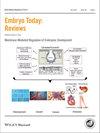Fetal programming of neuropsychiatric disorders.
G. Faa, M. Manchia, R. Pintus, C. Gerosa, M. A. Marcialis, V. Fanos
求助PDF
{"title":"Fetal programming of neuropsychiatric disorders.","authors":"G. Faa, M. Manchia, R. Pintus, C. Gerosa, M. A. Marcialis, V. Fanos","doi":"10.1002/bdrc.21139","DOIUrl":null,"url":null,"abstract":"Starting from the Developmental Origins of Health and Disease (DOHaD) hypotheses proposed by David Barker, namely fetal programming, in the past years, there is a growing evidence of the major role played by epigenetic factors during the intrauterine life and the perinatal period. Furthermore, it has been assessed that these factors can affect the health status in infancy and even in adulthood. In this review, we focus our attention on the fetal programming of the brain, analyzing the most recent literature concerning the epigenetic factors that can influence the development of neuropsychiatric disorders such as bipolar disorders, major depressive disorders, and schizophrenia. The perinatal epigenetic factors have been divided in two main groups: maternal factors and fetal factors. The maternal factors include diet, smoking, alcoholism, hypertension, malnutrition, trace elements, stress, diabetes, substance abuse, and exposure to environmental toxicants, while the fetal factors include hypoxia/asphyxia, placental insufficiency, prematurity, low birth weight, drugs administered to the mother or to the baby, and all factors causing intrauterine growth restriction. A better comprehension of the possible mechanisms underlying the pathogenesis of these diseases may help researchers and clinicians develop new diagnostic tools and treatments to offer these patients a tailored medical treatment strategy to improve their quality of life. Birth Defects Research (Part C) 108:207-223, 2016. © 2016 Wiley Periodicals, Inc.","PeriodicalId":55352,"journal":{"name":"Birth Defects Research Part C-Embryo Today-Reviews","volume":"1 1","pages":"207-223"},"PeriodicalIF":0.0000,"publicationDate":"2016-09-01","publicationTypes":"Journal Article","fieldsOfStudy":null,"isOpenAccess":false,"openAccessPdf":"","citationCount":"113","resultStr":null,"platform":"Semanticscholar","paperid":null,"PeriodicalName":"Birth Defects Research Part C-Embryo Today-Reviews","FirstCategoryId":"1085","ListUrlMain":"https://doi.org/10.1002/bdrc.21139","RegionNum":0,"RegionCategory":null,"ArticlePicture":[],"TitleCN":null,"AbstractTextCN":null,"PMCID":null,"EPubDate":"","PubModel":"","JCR":"Q","JCRName":"Medicine","Score":null,"Total":0}
引用次数: 113
引用
批量引用
Abstract
Starting from the Developmental Origins of Health and Disease (DOHaD) hypotheses proposed by David Barker, namely fetal programming, in the past years, there is a growing evidence of the major role played by epigenetic factors during the intrauterine life and the perinatal period. Furthermore, it has been assessed that these factors can affect the health status in infancy and even in adulthood. In this review, we focus our attention on the fetal programming of the brain, analyzing the most recent literature concerning the epigenetic factors that can influence the development of neuropsychiatric disorders such as bipolar disorders, major depressive disorders, and schizophrenia. The perinatal epigenetic factors have been divided in two main groups: maternal factors and fetal factors. The maternal factors include diet, smoking, alcoholism, hypertension, malnutrition, trace elements, stress, diabetes, substance abuse, and exposure to environmental toxicants, while the fetal factors include hypoxia/asphyxia, placental insufficiency, prematurity, low birth weight, drugs administered to the mother or to the baby, and all factors causing intrauterine growth restriction. A better comprehension of the possible mechanisms underlying the pathogenesis of these diseases may help researchers and clinicians develop new diagnostic tools and treatments to offer these patients a tailored medical treatment strategy to improve their quality of life. Birth Defects Research (Part C) 108:207-223, 2016. © 2016 Wiley Periodicals, Inc.
神经精神障碍的胎儿编程。
从过去几年David Barker提出的健康与疾病的发育起源假说(Developmental Origins of Health and Disease, DOHaD)开始,即胎儿规划假说,越来越多的证据表明,表观遗传因素在宫内生活和围产期发挥了重要作用。此外,据评估,这些因素会影响婴儿甚至成年期的健康状况。在这篇综述中,我们将注意力集中在胎儿大脑的编程上,分析了最近关于影响神经精神疾病如双相情感障碍、重度抑郁症和精神分裂症发展的表观遗传因素的文献。围产期表观遗传因素主要分为两大类:母体因素和胎儿因素。母体因素包括饮食、吸烟、酗酒、高血压、营养不良、微量元素、压力、糖尿病、药物滥用和接触环境毒物;胎儿因素包括缺氧/窒息、胎盘功能不全、早产、低出生体重、母亲或婴儿服用的药物以及所有导致宫内生长受限的因素。更好地理解这些疾病的发病机制可能有助于研究人员和临床医生开发新的诊断工具和治疗方法,为这些患者提供量身定制的医疗策略,以提高他们的生活质量。出生缺陷研究(C辑)108:207-223,2016。©2016 Wiley期刊公司
本文章由计算机程序翻译,如有差异,请以英文原文为准。


